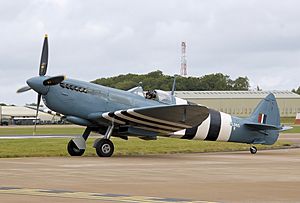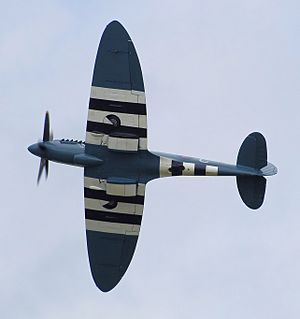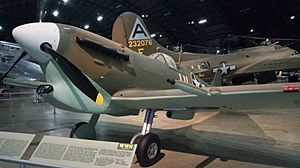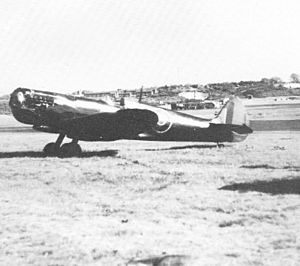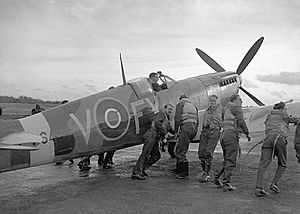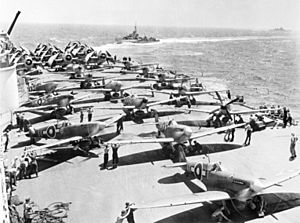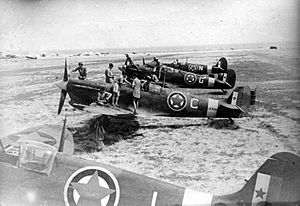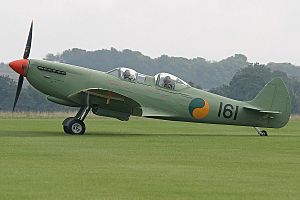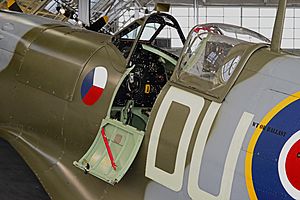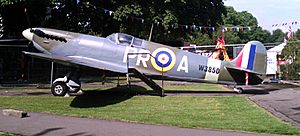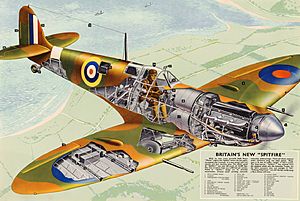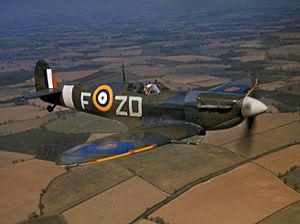Supermarine Spitfire facts for kids
Quick facts for kids Spitfire |
|
|---|---|
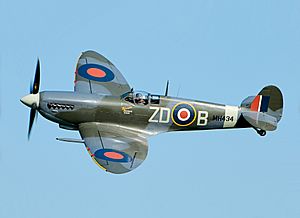 |
|
| Spitfire LF Mk IX, MH434 in flight 2018: This aircraft shot down a Focke-Wulf Fw 190 in 1943 while serving with No. 222 Squadron RAF. | |
| Role | Fighter / Interceptor aircraft |
| National origin | United Kingdom |
| Manufacturer | Supermarine |
| Designer | R. J. Mitchell |
| First flight | 5 March 1936 |
| Introduction | 4 August 1938 |
| Retired | 1961 (Irish Air Corps) |
| Primary users | Royal Air Force
|
| Produced | 1938–1948 |
| Number built | 20,351 |
| Variants | Supermarine Seafire |
| Developed into | Supermarine Spiteful |
The Supermarine Spitfire is a famous British single-seat fighter aircraft. It was used by the Royal Air Force (RAF) and other Allied countries. It flew before, during, and after World War II. Many versions of the Spitfire were built. These ranged from the first Mk 1 to the powerful Mk 24. It was the only British fighter plane made continuously throughout the war. The Spitfire is still very popular today. About 70 of them can still fly. Many more are on display in museums around the world.
The Spitfire was designed by R. J. Mitchell. He was the chief designer at Supermarine Aviation Works. The plane was meant to be a fast, short-range interceptor aircraft. This means it could quickly stop enemy planes. Mitchell created the Spitfire's special elliptical wing shape. This wing was designed by Beverley Shenstone. It helped the plane fly faster than other fighters of its time. Mitchell kept improving the design until he died in 1937. Then, his friend Joseph Smith took over. He guided the Spitfire through many different versions.
During the Battle of Britain in 1940, people thought the Spitfire was the main RAF fighter. But the Hawker Hurricane was more common. It did most of the work fighting the German Luftwaffe. Still, the Spitfire was a better fighter plane. Spitfire units lost fewer planes and shot down more enemies than Hurricane units. This was likely because the Spitfire performed better. In the battle, Spitfires usually fought German fighters. These were mainly Messerschmitt Bf 109E planes, which were a good match for them.
After the Battle of Britain, the Spitfire became the main plane for RAF Fighter Command. It was used in Europe, the Mediterranean, Asia, and Southeast Asia. Pilots loved the Spitfire. It flew in many roles, like stopping enemy planes, taking photos, bombing, and training. It kept flying until the 1950s. The Seafire was a version of the Spitfire made for aircraft carriers. It was used by the Fleet Air Arm from 1942. The original plane was built with a Rolls-Royce Merlin engine. It had 1,030 hp. The plane was strong enough to use even more powerful Merlin engines. Later versions used Rolls-Royce Griffon engines with up to 2,340 hp. This made the Spitfire much better over its years of service.
Contents
How the Spitfire Was Built
Early Designs and First Flight
In 1931, the Air Ministry wanted a new fighter plane. It needed to fly at 250 miles per hour (402 km/h). R. J. Mitchell designed the Supermarine Type 224 for this. But it was not chosen. Mitchell and his team then started new designs. They used what they learned from their fast Schneider Trophy seaplanes. This led to the Type 300. It had wheels that could hide away and smaller wings.
The design kept changing. It got a closed cockpit and oxygen equipment. It also got the new, powerful Rolls-Royce "Merlin" engine. In November 1934, Mitchell began detailed work on this improved Type 300. The Air Ministry ordered one plane to be built in December 1934. In April 1935, the guns were changed. Instead of two machine guns, it would have four .303 inch (7.7 mm) Browning guns.
On 5 March 1936, the first prototype Spitfire, K5054, took its first flight. It flew from Eastleigh Aerodrome. Captain Joseph "Mutt" Summers was the pilot. He said, "don't touch anything" when he landed. This first flight lasted eight minutes. It happened four months after the Hurricane's first flight.
After more tests, the Spitfire proved to be a very good plane. It was fast, reaching 348 mph (557 km/h) in level flight. On 3 June 1936, the Air Ministry ordered 310 Spitfires. This was even before a full report was ready.
Starting Production
The public first saw the Spitfire at an air show on 27 June 1936. Full production was supposed to start right away. But there were many problems. The first production Spitfire, K9787, was not ready until mid-1938. This was at the Woolston factory in Southampton.
Supermarine was a small company. It was already busy building other planes. So, the company planned to have other factories help build parts. But Vickers-Armstrongs, the parent company, was slow to share the plans. This caused more delays.
Because of these delays, the Air Ministry thought about stopping Spitfire production. But Supermarine and Vickers convinced them they could fix the problems. So, another order for 200 Spitfires was placed in March 1938. The first production Spitfire flew on 15 May 1938. This was almost two years after the first order. Each plane cost about £9,500. The most expensive parts were the body, the Merlin engine, and the wings.
Building Planes at Castle Bromwich
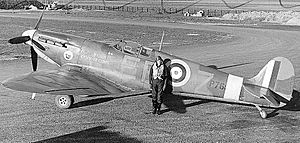
In 1935, the Air Ministry asked Morris Motors if they could build aircraft. In 1936, a plan called the shadow factory plan started. It aimed to build more British aircraft. Herbert Austin was in charge. He was to build nine new factories.
In 1938, work began on the Castle Bromwich Aircraft Factory (CBAF). It was next to an airfield. This factory was managed by Morris Motors. But the government paid for it. By early 1939, the factory's cost had more than doubled. Even when the first Spitfires were built in June 1940, the factory was not finished. It also had problems with workers. Building the Spitfire needed special skills. Workers had to be retrained. There were also issues with managers and threats of strikes.
By May 1940, Castle Bromwich had not built its first Spitfire. On 17 May, Lord Beaverbrook took control of the factory. He sent in experienced staff from Supermarine. In June 1940, 10 Mk IIs were built. Production quickly grew. By the time the factory stopped making Spitfires in June 1945, it had built 12,129 planes. This made CBAF the biggest Spitfire factory in the UK.
Spreading Out Production
During the Battle of Britain, the Luftwaffe tried to bomb the main factories. On 26 September 1940, both factories were destroyed. Many people were killed or hurt. Luckily, many tools had already been moved. Production was spread out to smaller places. These included garages and other workshops.
A special factory was built in Caversham, Reading. It focused on building the plane bodies and installing engines. The design office moved to Hursley Park. This place also had a hangar for putting together prototype Spitfires. But no planes ever flew from Hursley.
Completed Spitfires were taken to airfields on large trailers. There, they were put together, tested, and given to the RAF.
Testing the Planes
All Spitfires were tested before they were delivered. During World War II, Jeffrey Quill was the chief test pilot for Vickers Supermarine. He led a team of 10 to 12 pilots. They tested all Spitfires built in the Southampton area. Alex Henshaw was the chief test pilot at Castle Bromwich from 1940. He tested all Spitfires built there. Between 1940 and 1946, Henshaw flew over 2,360 Spitfires. This was more than 10% of all Spitfires ever made.
Henshaw wrote about testing Spitfires: "After checking the plane, I would take off. Once high enough, I would make sure it flew straight. Then, I would climb at full power. I would check the engine. If all was good, I would dive at full power. I would make sure it flew straight at 460 mph (740 km/h) Indicated Air Speed. I always did some aerobatic tests to see how it handled. The test flight was quick, about 20 to 30 minutes. Then, mechanics would fix any issues, and the Spitfire was ready."
He also said that later Spitfires were faster but heavier. They did not handle as well as the earlier ones. He explained that improving one part of a plane often means another part gets a little worse.
The last Spitfire was made in February 1948. A total of 20,351 Spitfires were built. This included two-seat trainer planes. Some Spitfires were still used in the 1950s. The Spitfire was the only British fighter plane made continuously before, during, and after World War II.
Spitfire Design Features
The Plane's Body
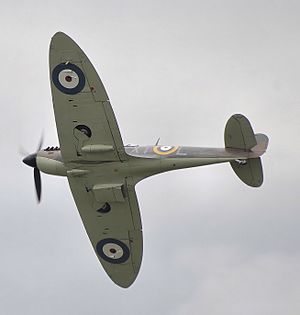
In the 1930s, plane designers were creating new fighter aircraft. Planes like the French Dewoitine D.520 and German Messerschmitt Bf 109 used new building methods. They had hidden landing gear, closed cockpits, and metal wings. These ideas were used in passenger planes years before. But the military was slow to use them. They liked the simpler biplanes.
Mitchell wanted to create a balanced, fast fighter. It needed to use the Merlin engine's power fully. But it also had to be easy to fly. The Spitfire was designed to climb quickly. This was to stop enemy bombers.
The Spitfire's body was complex. It had a smooth, metal-skinned body. This body was built over a skeleton of 19 frames. These frames helped make the plane light but strong. The skin was held on by rivets. In important areas, like the front of the wing, flush rivets were used. This meant they were flat with the surface. From 1943, flush riveting was used more on the body.
At first, parts like the ailerons (wing flaps), elevators (tail flaps), and rudder (tail fin) were covered in fabric. But in combat, fabric ailerons were hard to use at high speeds. So, light metal was used instead. This made the plane easier to control at all speeds.
The Special Wing Shape
In 1934, Mitchell and his team chose a semi-elliptical wing shape. This shape helped solve two problems. The wing needed to be thin to reduce drag. But it also needed to be thick enough to hold the landing gear, guns, and ammunition. An elliptical shape is very good for aerodynamics. It creates the least amount of drag when lifting. Mitchell was practical. The ellipse shape allowed the thinnest wing possible while still holding everything needed inside. It also looked nice.
The wing had a special design. It used five square tubes that fit inside each other. This made the main spar (the main support beam) very strong and light. The landing gear attached to this spar. It folded outwards and slightly backwards into the wing.
The front edge of the wing was also strong. It formed a D-shaped box. This part was first meant to hold steam condensers for an old cooling system. But when a new cooling system was used, this part was empty. Later, it was used to hold extra fuel tanks. Airflow through the main radiator was controlled by flaps. In early Spitfires, the pilot moved this flap by hand. Later, with more powerful engines, the flaps moved automatically.
Another wing feature was its "washout." The back edge of the wing twisted slightly upwards. This made the wing roots (part closest to the body) stall before the tips. This helped prevent the wing from dropping suddenly. It also warned the pilot by making the plane shake. This allowed even new pilots to fly the plane safely. The complex wing design caused delays in production at first. But by June 1939, most of these problems were solved.
The Spitfire had wing tips that could be removed. For high-altitude flying, longer, "pointed" tips were used. These made the wingspan wider. For other versions, "clipped" wings were used. These were shorter. The wing tips were made of wood with a light metal skin.
The flaps on the wing's back edge were also controlled by air pressure. They had only two positions: fully up or fully down. Flaps were usually lowered only for landing.
The elliptical shape was also used for the tail fin and tailplane. This helped with aerodynamics. As later Spitfires got bigger engines, their tails became larger. This was to keep the plane balanced.
Better Wing Designs Later On
As the Spitfire got more powerful, it could fly faster. This meant pilots could have trouble controlling the ailerons. So, the Supermarine team redesigned the wings. The new wing for the Spitfire F Mk 21 was much stiffer. It also had new ailerons. This made the plane much easier to control at high speeds.
Supermarine also tried a new "laminar-flow" wing. This wing was designed to reduce drag even more. It was first put on a Spitfire Mk XIV. Later, a new plane body was designed, leading to the Supermarine Spiteful.
Fuel System
Early Merlin engines did not have fuel injection. This meant Spitfires could not dive straight down like German Bf 109s. If a Spitfire dived too steeply, its fuel would be pulled away from the engine. This would cause the engine to cut out. RAF pilots learned to "half-roll" their planes before diving. This kept the fuel flowing.
In March 1941, a simple metal disc with a hole was added to the fuel line. This helped control fuel flow. It was invented by Beatrice "Tilly" Shilling. It became known as "Miss Shilling's orifice". Later, better fuel systems were added to the Merlin engines.
Guns and Weapons
At first, Spitfires had only four machine guns. This was because there weren't enough guns. Early tests showed the guns could freeze at high altitude. This was fixed by adding hot air ducts to the guns. Red fabric patches covered the gun ports. They protected the guns from cold and dirt until they were fired.
Even with eight machine guns, pilots found they were not strong enough for larger enemy planes. It took about 4,500 rounds to shoot down an enemy aircraft. So, a stronger weapon was needed. In June 1939, a Spitfire was fitted with two 20 mm Oerlikon cannon. These guns needed large bumps on the wings to cover their ammunition drums. The cannons often jammed.
Still, 30 more cannon-armed Spitfires were ordered. They were called the Mk IB. They were delivered to No. 19 Squadron in June 1940. But the cannons were so unreliable that the squadron asked for older, machine gun-armed planes instead. By August, Supermarine had improved the cannon system. They also added four .303 machine guns in the outer wings. These improved fighters were then given back to 19 Squadron.
Spitfire in Action
Service with the RAF
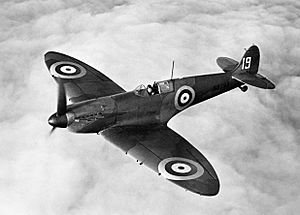
The Spitfire first flew with the RAF on 4 August 1938. It became famous during the Battle of Britain. This was helped by the "Spitfire Fund," which raised money for more planes.
During the battle, the Hurricane was more common. It did most of the fighting. But the Spitfire had better performance. Spitfire squadrons lost fewer planes and shot down more enemies. The main goal was to stop German bombers. Spitfires usually fought German fighter planes, like the Bf 109s. Hurricanes then attacked the bombers.
Many famous pilots flew the Spitfire. These included "Johnnie" Johnson, Douglas Bader, and "Bob" Tuck. Pilots from other countries also flew Spitfires. These included George Beurling from Canada and "Sailor" Malan from South Africa.
The Spitfire took on many different jobs during and after World War II. It became the first high-speed photo-reconnaissance plane for the RAF. These planes flew without guns. They took photos deep inside enemy territory. They provided important information throughout the war.
In 1941 and 1942, Spitfires took the first photos of German radar systems. In 1943, they helped confirm that Germany was building V1 and V2 "vengeance weapons." They did this by photographing Peenemünde on the Baltic Sea coast.
In the Mediterranean, Spitfires helped defend Malta from heavy attacks. From 1943, they helped prepare for the Allied invasions of Sicily and Italy. On 7 March 1942, 15 Mk Vs flew 600 miles (966 km) from a ship to Malta. These were the first Spitfires to serve outside Britain.
Spitfires also served on the Eastern Front with the Soviet Air Force. The first Spitfire Mk VB planes arrived in early 1943. Most of them were used for air defense. In 1944, the USSR received the much better Mk IX version. A total of 1,185 Mk IX planes were delivered.
In the Pacific, Spitfires fought Japanese Mitsubishi A6M Zero planes. The Zero was not as fast as the Spitfire. But it could turn better and stay in the air longer. Spitfire pilots used "slash and run" tactics. They used their speed to attack and then escape. They avoided turning fights. The Allies gained air superiority when the Mk VIII Spitfire arrived. In one fight, New Zealand pilot Alan Peart fought two dozen Japanese planes alone. He shot down one.
Southeast Asia was a lower priority. So, fewer Spitfires were sent there. This allowed the Japanese to gain air superiority by 1942. In Australia, RAF and Royal Australian Air Force Spitfires defended Darwin from Japanese attacks. They suffered heavy losses due to their limited fuel. Spitfire MKVIIIs also helped in the last battle of World War II in Burma. They attacked ground targets.
Spitfires were also used by the United States Army Air Forces in the 4th Fighter Group. This was until they were replaced by Republic P-47 Thunderbolts in March 1943. Some Spitfires were captured by the Germans. They were tested and sometimes secretly flown by enemy aircraft units.
Speed and Altitude Records
In late 1943, high-speed diving tests began. They looked at how planes handled near the sound barrier. A Spitfire XI was chosen because it could fly very fast. During these tests, a Spitfire flown by Squadron Leader J. R. Tobin reached 606 mph (975 km/h or Mach 0.891) in a dive.
In April 1944, the same plane had an engine failure during another dive. The propeller broke off. The plane reached Mach 0.92 (998 km/h). This was the fastest speed ever recorded for a propeller-driven plane. The pilot, Squadron Leader Anthony F. Martindale, blacked out. But he woke up and landed the plane safely. He was given the Air Force Cross for his bravery.
On 5 February 1952, a Spitfire 19 reached probably the highest altitude ever for a Spitfire. The pilot, Flight Lieutenant Edward "Ted" Powles, climbed to 50,000 feet (15,240 m). The cabin pressure dropped. He entered a dive that shook the plane violently. He regained control and landed safely. Data suggested he reached 690 mph (1,110 km/h) in the dive. This would be the fastest speed for a propeller plane if the instruments were more reliable.
Jeffrey Quill said it was amazing that a normal production plane like the Spitfire could be controlled at such speeds. Early jet planes like the Gloster Meteor could not. This showed how well Reginald Mitchell's design worked for high-speed flight.
Spitfire Versions
Overview of Variants
R. J. Mitchell designed the Spitfire. But he died early in 1937. So, his team, led by Joe Smith, continued its development. Joe Smith became Supermarine's chief designer. Jeffrey Quill said, "If Mitchell was born to design the Spitfire, Joe Smith was born to defend and develop it."
There were 24 main versions of the Spitfire. Many sub-versions also existed. These included planes with Merlin and later Griffon engines. There were also fast photo-reconnaissance versions. Different wings were used with various weapons. The A wing had eight .303 inch (7.7 mm) machine guns. The B wing had four .303 machine guns and two 20 mm cannons. The C, or universal, wing could hold four 20 mm cannons or two 20 mm cannons and four .303 machine guns. As the war went on, the C wing became more common. The E wing had two 20 mm cannons and two .50 inch (12.7 mm) Browning machine guns.
The Spitfire got faster and had better weapons. But its fuel tanks were small. This limited how far it could fly. Only the photo-reconnaissance versions had extra fuel tanks instead of guns.
Supermarine also made a two-seat version for training, called the T Mk VIII. But none were ordered. Only one was ever built. Some old Spitfires were later changed into two-seaters. These were used for training. After the war, Supermarine built more two-seat Spitfires. Ten of these TR9 versions were sold to the Indian Air Force. Others went to Ireland, the Netherlands, and Egypt.
The Seafire
The Seafire was a naval version of the Spitfire. It was made for use on aircraft carriers. The Spitfire was not designed for carrier landings. It had poor visibility over the nose. Pilots had to be trained to land looking out the side. The landing gear was also narrow. This made carrier landings tricky. Early Seafires were similar to regular Spitfires. But later versions had stronger bodies, folding wings, and arrestor hooks. These were for landing on carriers.
The Seafire II could fly better than the Japanese A6M5 Zero at low altitudes. This was shown in wartime tests. But other Allied carrier fighters, like the F6F Hellcat and F4U Corsair, were stronger. They were more practical for carrier use. Later Seafires with Griffon engines were much faster. But they came too late for World War II.
Griffon-Engined Versions
The first Spitfire with a Griffon engine, the Mk XII, flew in August 1942. It started flying with 41 Squadron in April 1943. This plane could reach almost 400 mph (644 km/h). It could climb to 33,000 feet (10,058 m) in under nine minutes.
As American fighters took over long-range escort duties, Griffon-engined Spitfires became air superiority fighters. They were important in stopping V-1 flying bombs. Merlin-engined Spitfires were used as fighter-bombers. Later Griffon Spitfires were heavier. They lost some of the easy handling of earlier models. But they could still outmaneuver German, American, and British fighters.
The last Spitfire version, the Mk 24, first flew on 13 April 1946. The very last production Spitfire, VN496, left the factory on 20 February 1948. This was almost 12 years after the first prototype flew. Spitfire Mk 24s were used by 80 Squadron in Germany and later in Hong Kong. They defended Hong Kong during the Chinese Civil War.
During the Malayan Emergency, Spitfires flew over 1,800 missions against Communists. The last RAF Spitfire mission was on 1 April 1954. It was a PR Mk 19 Spitfire. It flew from Singapore to photograph a jungle area in Malaysia. The ground crew painted 'The Last' on its nose.
The last non-operational flight of an RAF Spitfire was on 9 June 1957. It was a PR Mk 19. This was also the last known flight of a propeller-driven fighter in the RAF. Syria was the last country in the Middle East to use Spitfires. They kept their F Mk 22s until 1953.
In 1962, Air Marshal Sir John Nicholls tested a Spitfire against a English Electric Lightning F 3. The Lightning was a supersonic jet fighter. The goal was to develop tactics against the Indonesian Air Force's P-51 Mustang. Pilots found that the Lightning's missiles had trouble hitting the Spitfire. This was because the Spitfire's exhaust was not hot enough. They decided that the Lightning's cannons were the only good weapons. But the Spitfire's tight turns made it hard for the Lightning to hit. They concluded that the best way for a jet to attack a propeller plane was to dive from below and then circle behind for a quick attack.
Who Used the Spitfire
 Australia Australia
Australia Australia Belgium Belgium
Belgium Belgium Burma Burma
Burma Burma Canada Canada
Canada Canada Czechoslovakia Czechoslovakia
Czechoslovakia Czechoslovakia Denmark Denmark
Denmark Denmark Egypt Egypt
Egypt Egypt France France
France France Free France Free France
Free France Free France Greece Greece
Greece Greece Hong Kong Hong Kong
Hong Kong Hong Kong India India
India India Indian Empire
Indian Empire Indonesia Indonesia
Indonesia Indonesia Ireland Ireland
Ireland Ireland Israel Israel
Israel Israel Kingdom of Italy Kingdom of Italy
Kingdom of Italy Kingdom of Italy Italy Italy (Italian Republic)
Italy Italy (Italian Republic) Netherlands Netherlands
Netherlands Netherlands New Zealand New Zealand
New Zealand New Zealand Norway Norway
Norway Norway Pakistan Pakistan
Pakistan Pakistan Poland Poland
Poland Poland Portugal Portugal
Portugal Portugal Southern Rhodesia Southern Rhodesia
Southern Rhodesia Southern Rhodesia South Africa South Africa
South Africa South Africa Soviet Union Soviet Union
Soviet Union Soviet Union Sweden Sweden
Sweden Sweden Syria Syria
Syria Syria Thailand Thailand
Thailand Thailand Turkey Turkey
Turkey Turkey United Kingdom United Kingdom
United Kingdom United Kingdom United States United States
United States United States Yugoslavia Yugoslavia
Yugoslavia Yugoslavia
Spitfires Still Around
There are 54 Spitfires and a few Seafires that can still fly today. Many museums also have them on display. For example, Chicago's Museum of Science and Industry has a Spitfire next to a German Stuka dive bomber.
The oldest surviving Spitfire is a Mark 1, serial number K9942. It is at the Royal Air Force Museum Cosford in Shropshire. This plane was the 155th built. It first flew in April 1939. It flew in combat until June 1940. After repairs, it was used for training. It later became a museum piece.

One of the most original Spitfires is at Fantasy of Flight in Polk City, Florida. It was restored using almost 90% of its original parts. It even has its original machine guns, cannon, and radios.
Two Mk 1 Spitfires that can fly are at the Imperial War Museum Duxford in England. One was given to the museum. The second was sold for a record £3.1 million in 2015. Imperial War Museum Duxford has the largest collection of Spitfires.
One Spitfire is kept in flying condition at the Israeli Air Force Museum. A Spitfire model ML407 was bought by Carolyn Grace and her husband Nick in 1979. Carolyn Grace has flown it in many air shows.
Search for Buried Spitfires in Burma
After the war in Asia ended in 1945, some Spitfire Mk.XIVs were said to be buried in crates in Burma. They were greased and prepared for long storage. But searches at Yangon International Airport in early 2013 found no evidence of these planes. A former RAF pilot, Pat Woodward, said no such burying happened. In 2016, reports said the search was still going on.
Spitfire Memorials
- A replica of a Spitfire Mk1 is at the Battle of Britain memorial near Folkestone. It is next to a replica Hurricane.
- Sentinel is a sculpture by Tim Tolkien. It shows three Spitfires flying. It is at a roundabout in Castle Bromwich, Birmingham. This remembers the main Spitfire factory. There is also a Spitfire and Hurricane at the nearby Thinktank Science Museum.
- A sculpture of the prototype Spitfire, K5054, is at the entrance to Southampton International Airport. This is where the plane first flew in 1936.
- Jeffrey Quill helped build an exact replica of K5054. It is a memorial to R.J. Mitchell. It was shown to the public in 1993. It is now at the Tangmere Military Aviation Museum.
- A replica Spitfire is at RAF Northolt. It is painted in the colors of a Polish squadron.
- A replica Spitfire Mk XVI is on a pole in Memorial Park, Hamilton, New Zealand. It honors all New Zealand fighter pilots who flew Spitfires.
- At RAF Bentley Priory, there are replicas of a Spitfire Mk 1 and a Hurricane Mk 1. They are shown in an attack position. This is a memorial to those who worked there during the war.
- A replica Spitfire is next to the Edinburgh Airport control tower. It represents a plane from 603 (City of Edinburgh) Squadron.
- A replica Spitfire Mk IX is on a pole in Jackson Park, Windsor, Ontario, Canada. It is next to a Hurricane. This remembers Royal Canadian Air Force pilots.
- One of the few Spitfires with a wartime record is at the RAF Manston Spitfire and Hurricane Memorial Museum.
- Lodge Hill Garage in Abingdon, Oxfordshire has a full-size replica Spitfire on its roof. This is part of a campaign to honor the 166 women from the Air Transport Auxiliary (ATA). They flew Spitfires and other planes during the war.
- A replica Spitfire Mk IX is on the roof of the Spitfire Emporium shop in Kitchener, Ontario.
- There is a replica Spitfire (and Hurricane) at the entrance to the Eden Camp Modern History Museum. It is a memorial to Battle of Britain pilots.
- Montrose Air Station Heritage Centre has a full-size replica Spitfire MkVb. It is a memorial to the men and women who served there.
- A replica of Spitfire VB BL924 is at Beale Park. It honors Aksel Svendsen, a Danish RAF pilot who died in 1942.
- In 2021, a full-size replica was put on a pole at a Salisbury factory site.
- In 2009, the Spitfire was chosen for a British postage stamp series called "British Design Classics."
Restored Planes and Replicas
The Aircraft Restoration Company in Britain has restored or built many flying Spitfires. Other companies also make replica Spitfires. These can be full-size or smaller. Most use wood instead of metal. Examples include the Jurca Spit from France. Supermarine Aircraft makes 80% scale Spitfire Mk26 and 90% scale Mk26B replicas. Their Supermarine Aircraft Spitfire kit is the only all-aluminum replica in production. The Isaacs Spitfire and Time Warp Spitfire Mk V are home-built 60% scale replicas. Bob DeFord built a 100% scale replica.
The Greenwood Military Aviation Museum also has a non-flying Spitfire replica.
Spitfire in Movies and Shows
During and after the Battle of Britain, the Spitfire became a symbol of British strength. The "Spitfire Fund" helped make it famous. The Spitfire is still popular at airshows and museums. It holds a special place in the memories of those who flew it. Many films and documentaries feature the Spitfire.
- The First of the Few (1942) is a British film. It stars Leslie Howard as R. J. Mitchell. It shows the story of the Spitfire's development. Some scenes used real Spitfires and pilots from 1941.
- Malta Story (1953) tells the story of Malta's defense in 1942. Spitfires were the island's main defense.
- Reach for the Sky (1956) tells the story of Douglas Bader. It uses real Spitfire planes.
- Battle of Britain (1969) is set in 1940. It features 12 flying Spitfires and other World War II planes.
- Piece of Cake (1987) is a TV series. It shows air combat during the early part of World War II. It uses later model Spitfires instead of Hurricanes.
- Dark Blue World (2001) is about two Czech pilots who fly Spitfires in the Battle of Britain.
- Guy Martin's Spitfire (2014) is a documentary. It shows the restoration of a Mark 1 Spitfire. This plane was buried for 46 years after crashing in 1940.
- Dunkirk (2017) features three Spitfires defending the evacuation of troops from Dunkirk.
- Spitfire: The People's Plane (2020) is a podcast. It tells the story of the people who built the aircraft.
Spitfire Mk Vb Specs
Data from Spitfire: The History and Jane's Fighting Aircraft of World War II.
General characteristics
- Crew: 1
- Length: 29 ft 11 in (9.12 m)
- Wingspan: 36 ft 10 in (11.23 m)
- Height: 11 ft 5 in (3.48 m)
- Wing area: 242.1 sq ft (22.49 m2)
- Airfoil: root: NACA 2213; tip: NACA 2209.4
- Empty weight: 5,065 lb (2,297 kg)
- Gross weight: 6,622 lb (3,004 kg)
- Max takeoff weight: 6,700 lb (3,039 kg)
- Powerplant: 1 × Rolls-Royce Merlin 45 V-12 liquid-cooled piston engine, 1,470 hp (1,100 kW)
- Propellers: 3-bladed Rotol constant-speed propeller
Performance
- Maximum speed: 370 mph (595 km/h; 322 kn)
- Range: 479 mi (416 nmi; 771 km)
- Combat range: 248 mi (216 nmi; 399 km)
- Ferry range: 1,100 mi (956 nmi; 1,770 km) with fuel tank
- Service ceiling: 36,500 ft (11,100 m)
- Rate of climb: 2,600 ft/min (13 m/s)
- Wing loading: 27.35 lb/sq ft (133.5 kg/m2)
- Power/mass: 0.22 hp/lb (0.36 kW/kg)
Armament
- Guns:
- A wing
- 8 × .303 in Browning Mk II* machine guns (350 rounds per gun)
- B wing
- 2 × 20 mm Hispano Mk II (60 rounds per gun)
- 4 × .303 in Browning Mk II* machine guns (350 rounds per gun)
- C wing
- 4 × 20 mm Hispano Mk II cannon (120 rounds per gun)
- C wing (Alt.)
- 2 × 20 mm Hispano Mk II (120 rounds per gun)
- 4 × .303 in Browning Mk II* machine guns (350 rounds per gun)
- E wing
- 2 × 20 mm Hispano Mk II cannon (120 rounds per gun)
- 2 × .50 in M2 Browning machine guns (250 rounds per gun)
- A wing
- Rockets: 2 RP-3 rockets (1 under each wing)
See also
 In Spanish: Supermarine Spitfire para niños
In Spanish: Supermarine Spitfire para niños
- Similar aircraft



